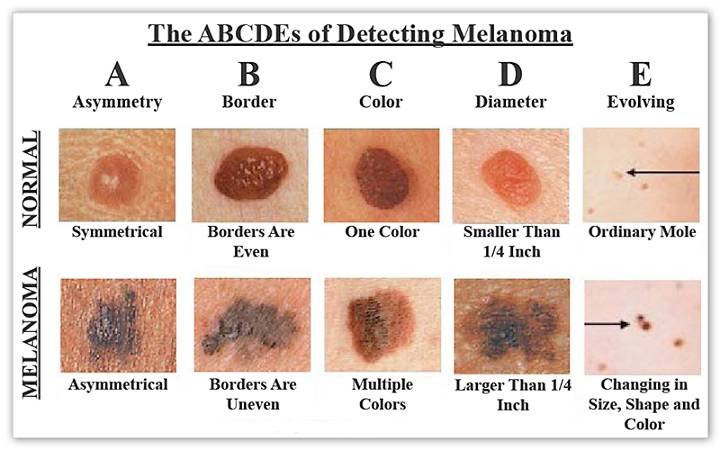
Are Moles and Spots on the Skin a Precursor to Skin Cancer? Quick Confirmation and Detection of the 4 Major Symptoms of Skin Cancer in the Early Stage
Many people don’t like to have overly conspicuous moles on their bodies, especially when they appear on the face, which can easily attract attention. But did you know that in addition to affecting your appearance, moles may also be “hidden dangers”? Especially when unknown black spots or moles appear on the skin, it is likely to be one of the good signs of skin cancer.
What exactly is skin cancer? In addition to the symptoms when skin cancer occurs, how to detect skin cancer, and which high-risk groups are prone to skin cancer, let us re-understand skin cancer together.
What is skin cancer?
Skin cancer is cancer that occurs when skin cells become cancer cells. The main cause of cell lesions is long-term exposure to ultraviolet radiation. For example, arms, backs of hands, face, scalp, ears, lips, or those who often wear shorts and expose their legs in summer are all susceptible to sun exposure. Areas of skin exposed to UV rays.
Coloured people generally do not have a deep understanding of skin cancer; because compared to white people, the skin of yellow people can secrete higher melanin, which can reduce the absorption of ultraviolet rays, so the chance of suffering from skin cancer is lower than that of white people.
What are the early signs of skin cancer? 4 major skin cancer symptoms to look at at once
Skin cancer symptoms vary depending on the type. It can generally be divided into three types: basal cell carcinoma, squamous cell carcinoma, and melanoma. However, the vast majority of skin cancers usually have no symptoms and are neither painful nor itchy. Fortunately, the skin is something we can see and touch. By observing the texture and color of the skin, it can help to determine early whether there are signs of skin cancer. Here are 4 major skin cancer symptoms and characteristics:

- Basal cell carcinoma
Basal cell carcinoma (Basal cell carcinoma) commonly occurs in skin areas that are frequently exposed to sunlight, such as the neck or face. It mainly affects the elderly and is the most common type of skin cancer. As mentioned earlier, the rise in the number of skin cancer cases may also be related to Taiwan’s aging population structure. Possible symptoms of basal cell carcinoma include:
- The lesions have keratinization, hard nodules, and erythema, and the surface is rough, crusted, and squamous, and patients are prone to itching.
- They are usually reddish in color and may bleed easily from ulcers.
- The lesions may develop into large, mushroom-shaped masses.
- The lesions have keratinization, hard nodules, and erythema, and the surface is rough, crusted, and squamous, and patients are prone to itching.
- Squamous cell carcinoma
Squamous cell carcinoma is similar to basal cell carcinoma and is also caused by long-term exposure to sunlight. It is the second most common type of skin cancer in the elderly. Possible symptoms include:
- The lesions have keratinization, hard nodules, and erythema, and the surface is rough, crusted, and squamous, and patients are prone to itching.
- They are usually reddish in color and may bleed easily from ulcers.
- The lesions may develop into large, mushroom-shaped masses.
- The lesions have keratinization, hard nodules, and erythema, and the surface is rough, crusted, and squamous, and patients are prone to itching.
- Melanoma
Melanoma (also known as malignant melanoma) is the least common but most serious type of skin cancer. It may appear on the skin anywhere on the human body, causing existing moles to become cancerous and prone to metastasis. The following are common characteristics of melanoma:
- The lesions appear as raised nodules or plaques.
- The color is darker, but the pigment is not evenly distributed. One area may be black and the other may be skin color.
- The edges of the lesions are irregularly shaped.
- The lesions appear as raised nodules or plaques.
- Bowen’s disease caused by arsenic poisoning
In addition to the three common types of skin cancer listed above, some elderly people also have the problem of Bowen’s disease, which is actually the same as Blackfoot disease because drinking well water and ground water containing high levels of arsenic. Over time, lesions appear on the skin due to chronic arsenic poisoning, which may further develop into squamous cell carcinoma.
Skin cancer causes?
- People with fair skin:
White skin means less melanin, which can help protect against ultraviolet rays, which is why white people are particularly susceptible to skin cancer. - Excessive exposure to the sun:
People who like outdoor sports or have to be in the sun for a long time at work will have a higher threat to the skin from ultraviolet rays than other people. Especially if they do not use sun protection, they are not only prone to sunburn, but also have a risk of skin cancer. will also improve. - People with many moles:
People with many moles on their bodies have a higher chance of developing abnormal moles than the average person. These abnormal moles are irregular in shape and larger than normal moles, making them prone to cancer. - Actinic keratosis:
also known as actinic keratosis, skin lesions that appear in patients due to long-term exposure to sunlight. Patients will have brown or red scab plaques that may evolve into squamous cells. Possibility of cancer. - Family history
Have a family history of skin cancer. - Radiation
Prolonged exposure to radiation. - Weak immune system
People with weak immune systems such as AIDS patients. - Arsenic
Arsenic poisoning. - Genetic defects
Genetic defects in DNA repair mechanisms, such as xeroderma pigmentosum and Muir-Torre syndrome, also place affected individuals at high risk for skin cancer.

Is mole on the body suspected of skin cancer? Skin cancer diagnosis and self-examination
Early detection of skin cancer is very important. If the tumor has grown large and metastasized to lymph nodes or even other internal organs, the patient’s survival rate will be significantly reduced.
When diagnosing skin cancer, in addition to making preliminary judgments with the naked eye, doctors can also use skin biopsy (biopsy) to remove small pieces of tissue from the lesions and use an analyzer to determine whether it is skin cancer.
After skin cancer is diagnosed, the doctor will conduct further examinations based on the type of skin cancer. For example, melanoma is easy to metastasize to other parts of the body, and imaging examinations such as computed tomography (CT scan), X-ray, and magnetic resonance imaging (MRI) may be required. Grasp the movements of cancer cells more accurately.
How to check for skin cancer yourself?
In addition to going to the hospital for diagnosis, daily examinations at home are actually more important. You can use the ABCDE examination formula to help you detect skin abnormalities early and seek medical treatment.

In addition, studies have found that people of color (black and yellow) have a higher proportion of melanoma, and tumors usually grow in areas that are not easily exposed to sunlight, such as the palms of the hands, the soles of the feet, or under the fingernails and toenails. Therefore, special attention should be paid to whether there are any abnormal skin changes in these areas during the examination.
When should I seek medical attention?
According to the ABCDE examination formula, if you find that new lumps, tumors or plaques appear on your skin, and they gradually grow, or even ulcers and bleeding occur, and they fail to heal for more than 1 month, you should go to the dermatology department for further examination.
Skin cancer staging
Skin cancer has 4 stages: basal cell carcinoma, squamous cell carcinoma

Skin cancer treatment?
There are many surgical methods to treat skin cancer. Skin cancers detected early or in small areas can be treated with cryotherapy or laser. If it is melanoma, the risk of metastasis needs to be considered, and a variety of treatments may be needed to completely eliminate cancer cells.
- Cryotherapy:
Cryotherapy through liquid nitrogen is more effective in treating early-stage skin cancer, but is not suitable for melanoma. - Laser:
Use high-frequency electrosurgery or carbon dioxide laser to remove lesions, similar to cryotherapy, and are mostly used for early, small, superficial skin cancers. - Surgical excision:
The most widely used skin cancer treatment method, the cancer tissue and surrounding skin are surgically removed. The larger the lesion, the greater the scope and depth of the resection to avoid recurrence in the future. - Mohs surgery:
This surgery removes the diseased skin tissue layer by layer and then examines it through a microscope until it is confirmed that no cancer cells remain. It is mainly suitable for areas with a diameter greater than 2 centimeters and where large-scale skin removal is not possible based on aesthetics and functional integrity, such as skin cancers on the head/neck, hands and feet, genitals, etc. - Radiation therapy:
The use of high-energy radiation, such as X-rays, to irradiate lesions to kill cancer cells. It can be used as auxiliary or primary treatment depending on the situation. - Chemotherapy:
the use of specific drugs to kill cancer cells, but is not effective for basal cell carcinoma and squamous cell carcinoma. For superficial skin cancer, the use of ointments containing 5-FU may be somewhat helpful. For melanoma, drugs such as Dacarbazine (DTIC) and Nitrosourea are used, but the therapeutic effect is still not as good as other treatments. - Photodynamic therapy:
treatment using photosensitive drugs. Treatment methods include applying ointments, lotions or injections to the lesions, and then using special light irradiation and activation drugs to remove cancer cells. It is generally suitable for the treatment of actinic keratosis or other superficial skin cancers. - Immunotherapy:
drugs are used to boost the patient’s own immune system to destroy cancer cells. Related drugs include interferon (Interferon), interleukin (IL-2) and the latest immune checkpoint inhibitor (Immune checkpoint blockade). - Targeted therapy:
For the treatment of melanoma patients, if the patient is “BRAF V600 mutation positive”, target drug therapy can be considered. Related drugs include: Dabrafenib, Trametinib, Zelboraf, etc.

4 ways to prevent skin cancer
We know that ultraviolet rays are the main culprit of skin cancer, so prevention methods are closely related to sun protection. However, we should not stay at home completely because the human body still needs to rely on sun exposure to obtain vitamin D. Moderate sun exposure is the only way to maintain health. The only method. What are some ways that we can enjoy the sun while reducing the risk of skin cancer:
- Avoid going out at noon:
10 a.m. to 2 p.m. is usually the time when the sun is strongest. If you want to go out, it is recommended to avoid this time period as much as possible, or to stay indoors to avoid being exposed to strong ultraviolet rays. - Use sun protection:
Many men believe that tanning makes them look masculine, so they are generally less concerned about the importance of sun protection than girls. However, skin cancer has no gender distinction, so even men should still be careful. It is recommended to apply sunscreen, or wear long-sleeved clothes, a hat or sunglasses to protect yourself from the sun. In addition to choosing a sunscreen product with SPF 30 or above or PA+++ or above, you need to reapply it every 2 hours for effective sun protection. (Recommended reading: How to apply sunscreen? Reapply every 2 hours with SPF at least 30) - Avoid tanning machines:
Tanning machines, also known as tanning beds, emit ultraviolet rays that increase the risk of skin cancer. - Check your skin frequently:
You can check for abnormal moles or patches on your own through the ABCDE test mentioned earlier.











